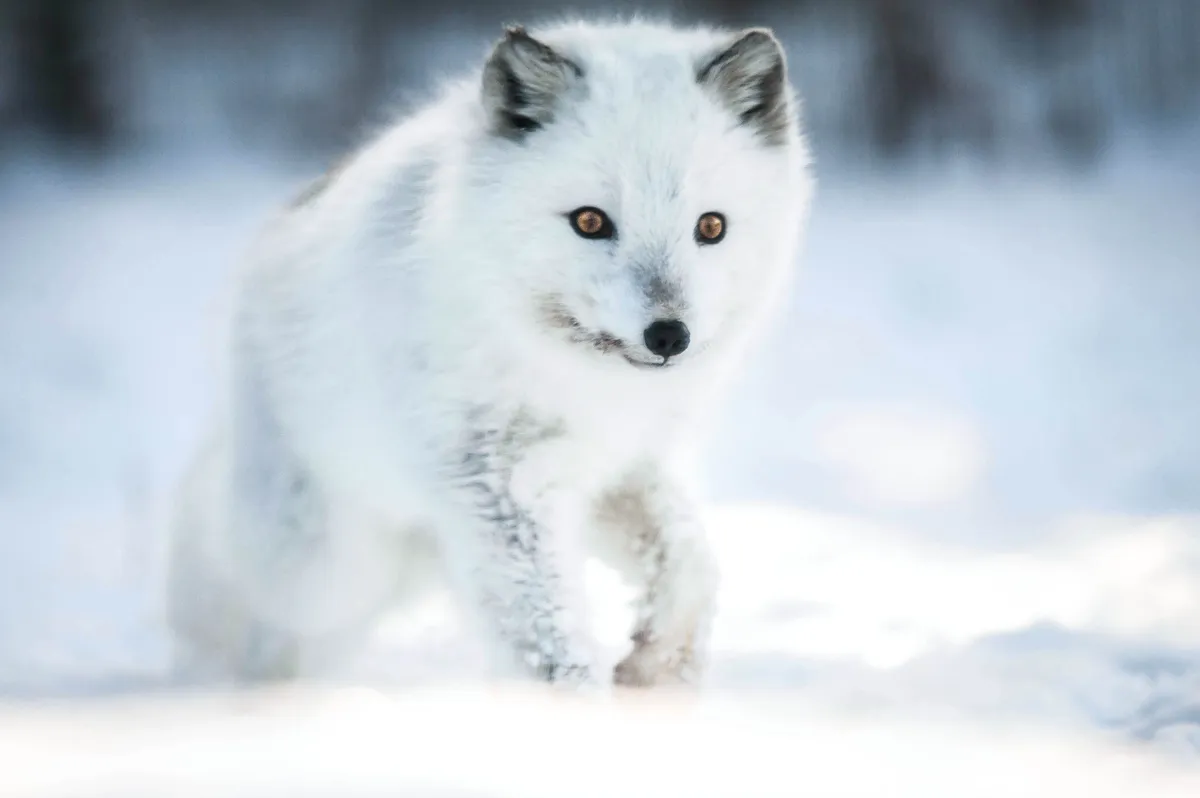Years ago, during a field trip to the Scottish island of Cumbrae, I came face to face with a stout bobtail squid. As I watched, rapt, the tiny mollusc blushed from ghostly pale to deep red and back again, like a magic performance. But this was no illusion.
What animals camouflage?
Squid are part of a whole spectrum of species that are able to change colour – an ability that comes with several speed settings. At its more relaxed end there is a handful of birds and mammals – including the Arctic fox, willow ptarmigan and snowshoe hare – that undergo a seasonal whitening triggered by waning day length. The transformation occurs as pigment disappears from fur and feathers. In mammal fur, this makes space for more air, which provides the added bonus of extra insulation as temperatures plummet.

Other environmental factors, such as ultraviolet, diet and surroundings, can also trigger gradual colour changes, involving alterations to the type and concentration of pigments within skin, exoskeleton, feathers or fur. A diet-driven transition is performed by several species of crab spiders, which ambush flower-visiting insects. The arachnids take about a week to morph from white to yellow, hiding in plain sight against their preferred backdrop of golden blooms.
For crustaceans, a slow colour change allows them to adapt to alterations in their environment. Chameleon prawns, for instance, transition between green and red, tracking the seasonal appearance of seaweed in their rocky shore habitat; shore crabs take on a more uniform colour as they mature, allowing them to blend in as they migrate onto the seabed of the subtidal zone.
Cryptic coloration - how animals are able to change colour and camouflage
Coloration in animals is achieved in several ways. In birds and mammals, skin cells known as melanocytes contain packages of melanin pigments, which produce blacks, browns, yellows and reds that can be combined in varying patterns. Birds can also gather pigments such as carotenoids through their diet to produce yellows and oranges, alongside the vivid greens, blues and violets created by the structure of their feathers.
The colour palette is expanded in fish, reptiles, amphibians, crustaceans and cephalopods (octopus, cuttlefish and squid), which are equipped with colour-producing cells known as chromatophores. These cells either contain pigment or produce iridescence, and there are several types, including melanophores (black, brown, red), xanthophores (yellow), erythrophores (orange and red), iridophores (iridescent colours) and leucophores (iridescent white).
Of these, the best understood are the melanophores. Pigment can be moved within the branch-shaped structure of the cell. When dark pigments are dispersed throughout the melanophore, they obscure the neighbouring chromatophores and make the animal appear darker; when concentrated into the centre, the surrounding colour becomes more visible.
The oval iridophores contain thin layers of crystal platelets that are mostly used to produce a range of shimmering blues, greens and silvers, according to how they are spaced and orientated. Iridescence is directional: a creature can appear utterly striking from one angle yet drab from another, allowing for targeted visuals. Hummingbirds, for example, use frenetic displays to appeal for a mate, and will position themselves at just the right angle to the sun in order to dazzle with their finery.
While birds rely on light to manipulate their iridescence, certain fish, including the paradise whiptail, can actually alter their appearance by varying the space between the layers of platelets in their iridophores. In doing so, they change the wavelength of light reflected by the cells and are thus able to rapidly switch their reflective head stripes from blue to red. Likewise, the diminutive blue-ringed octopus tweaks its iridophores to make a statement, throwing out a dazzling warning display when it starts to feel threatened.
Chromatophores are controlled either using hormones or neurons, allowing far swifter colour change than seen in seasonally shifting mammals and birds. The cells can be spread in a mosaic across the body or clustered to create patterns, such as the stripes of a zebrafish. In some reptiles, amphibians and fish, chromatophores are layered in the skin, with xanthophores closest to the surface, followed by the iridophores and finally the melanophores. This gives great potential for rapid appearance control and allows for striking displays.
Some frogs, lizards and crabs use their chromatophores as natural dimmer switches, adjusting their colour and brightness as day turns to night. While these daily changes provide camouflage – enabling, for instance, a frog to fade into a darkening forest floor, they may also play a role in temperature regulation and protection from damaging ultraviolet rays.
Colour and pattern are important elements of camouflage. Chameleons and fish have the ability to blend into their habitat, taking visual clues from their surroundings to guide decisions on which colour combination to deploy. Some fish, such as flounder (below), can match new backgrounds in a matter of seconds; others, including sole, fine-tune over days.

Natural habitats can be complex, though, with certain colours and textures inherently more challenging to replicate. While flatfish are adept at blending in with finer sediments such as sand and gravel, rocks can present a challenge. The fish, therefore, select substrates they are better able to mimic. Behavioural adjustments, from the waving appendages of stonefish that liken them to seaweed, to the characteristic quivering walk of chameleons that obscures them among rustling leaves, boost the chance of the ruse succeeding.
How camouflage is more about than blending into the background
Camouflage can be a crucial defence against the threat of predation, ensuring a species remains undetected, unrecognised or untargeted. While background matching is a widespread tactic, it can be less useful when a species is highly mobile and a habitat changeable. Here, other tricks, such as disruptive patterning, may be used. Bold markings create visual ‘noise’ that breaks up a shape, making it hard to discern where an animal begins and ends, and blurring the line between what is or isn’t a potential meal. A predator may fail to recognise its quarry entirely, or direct its attack to a less damaging area of the body.
Anything that is constantly transforming its size, shape or appearance is hard to locate, and cephalopods are undoubtedly some of the most confusing meals to catch. So complex are their chromatophores that they are considered organs in their own right, drawing together the pigment-filled cells with tiny muscles and nerves that all function as a unit. Pigments are held in pouch-like structures that can be rapidly compressed or flattened out. This detailed architecture provides precision-control over each chromatophore, and allows for mesmerising displays and vanishing acts alike.
With thousands of reflectors and chromatophores, cephalopods’ colour-shifting creativity enables them to face an unpredictable environment head-on. A choice of uniform, mottled and disruptive patterns helps them to hide in plain sight; muscle-controlled bumps on their skin (papillae) rapidly switch their skin from smooth to textured, allowing them to melt into barnacle-clad rocks or soft sediments.
Should they venture beyond the relative safety of rocky habitats and reefs, cephalopods can masquerade as patches of algae or coral. In an environment where there are fewer places to hide, the objective shifts from being unseen towards being unrecognised. You can be highly conspicuous, as long as you blend in.
Most species don’t have the luxury of having just one predator to avoid. Instead, they must manage multiple adversaries that have diverse hunting strategies and detection abilities. Colour-shifting skills can offer flexible lines of defence. Dwarf chameleons match their background more closely if their enemy is a bird, but brighten if it’s a snake.
This shows a fascinating awareness of their predators: snakes have relatively poor colour vision, and by dialling up the glare, the chameleon makes itself hard to pick out against a sunlit canopy. Cuttlefish also make proactive decisions dependent on the predator, opting to deploy their colour-changing prowess when threatened by visual predators such as flatfish, which actively search for prey, but beating a hasty retreat from sharks and crabs that hunt using entirely different senses.

Several deep-sea octopuses even include transparency within their armoury, helping them to evade predators by disguising their silhouette against the last rays of light filtering down to the twilight zone. At these depths, many species make their own light. The octopus can rapidly switch to red – a colour incredibly difficult to see in deep water, helping them to dodge the bioluminescent searchlights that would reflect off their internal organs if they were in transparent mode.
Octopuses are accomplished character actors and the wide repertoire of the mimic octopus includes disguising itself as venomous lionfish and sea kraits. Its soft body allows it to contort, and it embodies the guise of as flatfish by arranging its arms into undulating fins and bulging out its eyes. The dusky dottyback also sets its mind to mimicry. This unassuming reef fish switches between yellow and brown to match the damselfish with which it cohabits. With such similar appearances, the species will mingle closely, and the dottybacks reveal their motivations and proceed to eat any juvenile neighbours. It is a well-named case of ‘aggressive mimicry’.
Do animals change colour for other reasons?
But colour change isn’t always about hiding. Many species adorn themselves to stand out. Colour can communicate emotion or intent in an instant, allowing a species to determine willingness to mate, aggression or social hierarchy. Trinidadian guppies provide a subtle, but ominous, warning by changing their eyes from silver to black when competing for food. This sends a clear signal that they are prepared to fight and that an attack is imminent.
Octopuses, too, can use dark colours as they puff themselves up as part of an aggressive display. Such visual signals allow individuals to assess one another, judging risk before resorting to potentially damaging altercations. Chameleons assert their strength and dominance by biting, but may engage in a colour battle first: the brighter the skin, the more willing the contender.
Colour can also be attractive. For panther chameleons, it is a deciding factor for females selecting a mate, with males attempting to seduce them
with displays of reds, yellows, greens and blues. The females have exacting standards, preferring the suitors sporting the brightest shades.
From dimming-down frogs to seaweed-simulating prawns, wildlife is still offering up its secrets when it comes to colour change. Perhaps the greatest surprise of all is that, despite their talent for dynamic and dizzying performances, most cephalopods appear to be colour-blind.
